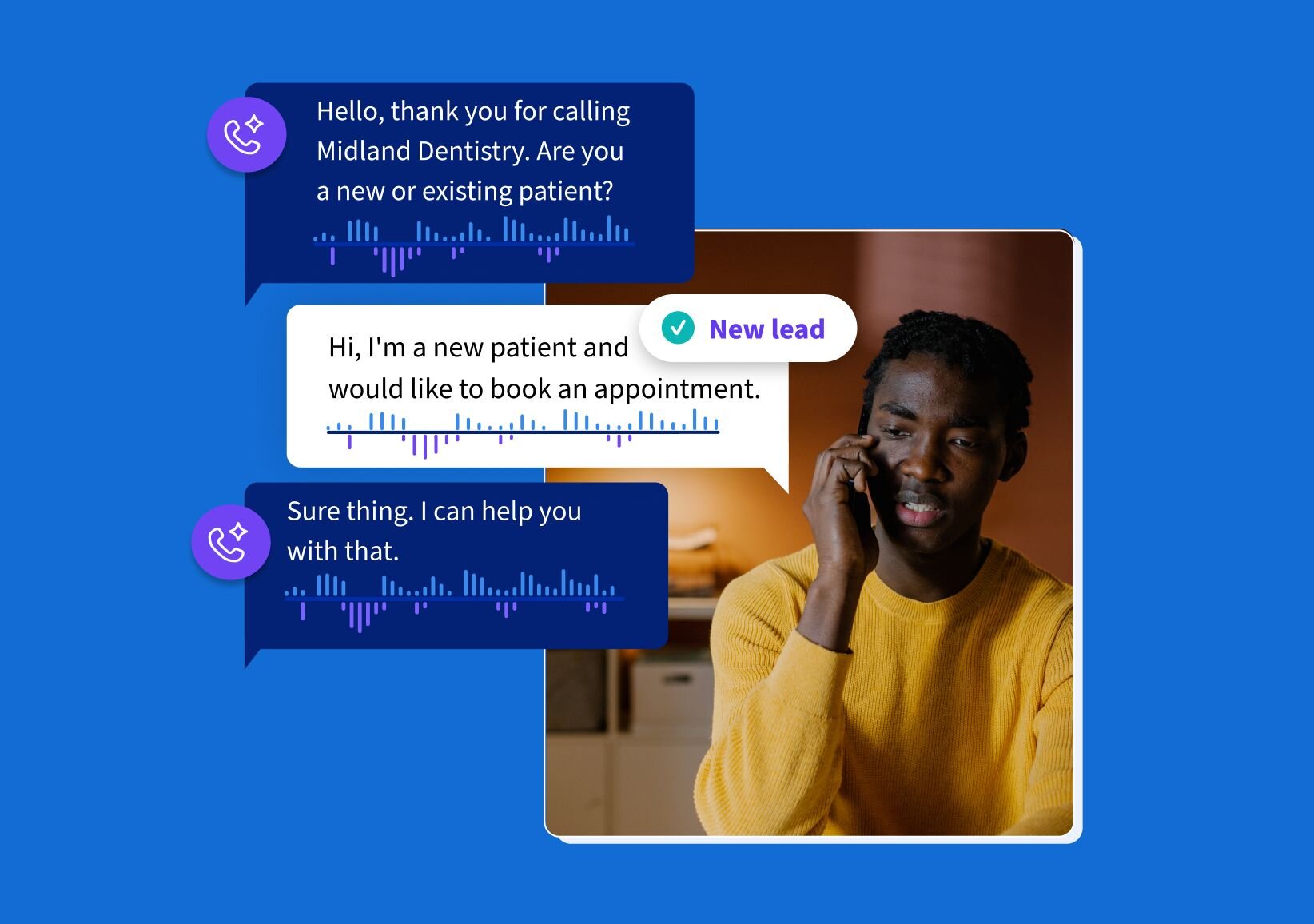Finding more clients doesn’t always mean having to spend more on ads. It means adapting to how people actually search, compare, and reach out for real estate today, and most businesses aren’t keeping up. Three-quarters of renters now search on mobile, comparing options across apps and feeds before they even reach your website. They also expect fast replies — responding within one minute can increase conversions by roughly 391%. Ignoring changes like these could be the difference between a stagnant pipeline and steady growth.
Consider this your seven-item punch list: practical, often overlooked tactics real estate professionals use to attract higher-intent leads, build brand equity, and close more deals without copying others.
Boost your reputation and build trust with automated review requests
The problem: Leaving reviews to chance won’t get you results. Word of mouth still drives deals, but in a digital-first world where online searches occur first, online reviews are crucial in building trust.
Why it matters: Buyers want to share their opinions about the service they receive. With 96% of consumers open to writing a review, all you need to do is make it easy and convenient for them to do so. Automating review requests taps a massive, underused trust engine for real estate.
How to build your online reputation with automated review requests
- Trigger an automatic review request via text or email the moment a deal closes. Keep it simple with direct links to your Google Business Profile and listing site of choice (eg, Zillow, Trulia, Redfin, or Realtor.com).
- Reply to every review. Short, relatable replies reinforce credibility, build trust, and help future buyers/renters choose you.
- Repurpose 5-star reviews into social posts, listing pages, and short videos to help the best feedback reach more consumers.
The outcome: Fresh, consistent reviews signal quality to both search engines and AI answer engines, improving your odds of being cited or recommended.
Rethink your search visibility strategy for an LLM, voice, and AI-search world
The problem: Ranking for “apartments for rent in [city]” on Google is important, but it isn’t enough to get you the visibility you need amid the rise of AI Overviews and LLMs like ChatGPT, Gemini, and Perplexity.
Why it matters: These days, renters on Google often don’t get past the AI Overview. Others are skipping Google entirely and heading straight to LLM platforms like ChatGPT and Perplexity to find information.
Increasingly, renters are asking questions by speaking directly to LLMs through speech prompts and voice-enabled devices, such as Google Assistant, Siri, and Alexa. This means a significant number of searchers will get their answer without ever looking at the top 10 search results, making a single click, or visiting a single webpage.
It helps to separate classic SEO from answer engines and LLMs before you plan your next move, so here’s what you need to know.
SEO vs. GEO vs. AEO vs. AIO:
- SEO: Optimize to rank in traditional search results.
- AEO (Answer Engine Optimization): Optimize to be the answer in engines that surface direct answers (and sources).
- GEO (Generative Engine Optimization): Optimize to increase visibility in LLM-generated answers.
- AIO (Artificial Intelligence Optimization): Use AEO’s direct-answer tactics and GEO’s location-based authority to get featured on a Search Engine Results Page’s AI-generated answers (AI snippets).
Google’s AI Overviews sit above organic results and answer queries directly, so buyers may never see your standard SERP listing. But, because AI Overviews and other answer engines often mirror top organic results, you can earn those citations by publishing clear, authoritative, well-structured content.
A dual strategy to apply for SEO vs GEO/AEO
For SEO (links):
- Publish hyper-local content that answers specific intents: “Best neighborhoods for young families in [area],” “Pros/cons of living in [subdivision],” “New construction vs. resale in [city],” etc. Build out neighborhood pages with schools, commute times, vibe, and price bands to satisfy a broader search intent.
For GEO/AEO (answers):
- Audit answer engines. Before optimizing, check which third-party listing sites and directories LLMs already cite for your target queries. Test how they answer questions about your own properties to find strategic opportunities and gaps.
- State the essentials in machine-friendly ways. Who you serve, the exact geography, price ranges, services, hours, and contact options, all presented in plain language and search-friendly labels, are all key details. Include clear “call” and “text” actions with a trackable number on every key page, and add structured data (LocalBusiness/Service + FAQ) so answer engines can cite you cleanly.
- Add concise FAQs. For the questions your clients actually ask, write answers in the same natural language renters/buyers use in voice or LLM prompts (e.g., “pet-friendly 2-bed near [landmark] under $X?”) to increase the odds of being quoted on LLMs.
- Include recent reviews and short videos on key pages. LLMs prioritize freshness, clarity, and corroboration, so incorporate source-friendly elements like plain-language summaries, bullet points, and labeled sections to enable models to extract accurate snippets with attribution.
- Keep NAP (name, address, phone) consistent across listings. This helps engines confidently cite you, so regularly audit NAP and tracking numbers across directories/ILS to prevent fragmentation and misattribution.
Make your outcome measurable: Add trackable phone numbers to your neighborhood pages and guides, tag CTAs with UTM parameters, and log call events in GA4 so you can see whether SEO and AI-driven discovery are actually generating calls.
Build your personal brand and show up everywhere with short-form videos
The problem: Video creation can feel intimidating or like “too much work.” Meanwhile, your future clients are scrolling short clips on TikTok, Reels, and Shorts.
Why it matters: People typically spend about two and a half hours per day on social media. Transcribed short-form videos meet them where they already are, build brand trust, and provide well-rounded answers to GEO/AEO questions.
How to build your personal brand with simple short-form videos
Try these simple, repeatable video posts:
- 30–45s “What $X buys you in [neighborhood].”
- Quick “state of the market” or “3 mistakes first-time buyers make” from your car between showings.
- “New to [community]? Here are 3 spots locals love.”
Level up your outcome: Use unique, per-platform tracking numbers from a call tracking solution in your video overlays and profiles to attribute calls and texts back to the source so you know which channels and topics actually drive showings.
Create a simple stay-in-touch plan that fuels reviews and referrals
The problem: Too many relationships end at the closing table, causing you to miss out on precious referrals and repeat transactions.
Why it matters: Word of mouth remains one of the most powerful forms of real estate marketing. Nurturing relationships, even after closing, can help compound your review flywheel and word-of-mouth while attracting warm, in-market referrals at low cost.
How to generate reviews and referrals with a simple stay-in-touch plan
- Schedule an automated 30-day check-in (call or text).
- Send an annual “home-iversary” note and add a personal touch with a tiny local gift card or market snapshot.
- Send quarterly neighborhood updates (inventory, median price, notable openings).
The outcome: More referrals and repeat business, stronger reviews and word of mouth, and lower acquisition costs as happy clients send warm leads your way.
Send a newsletter people actually read, save, and reply to
The problem: Most real estate newsletters are just listings — and get ignored.
Why it matters: Inbox fatigue is real: listing-only emails get skimmed or trigger unsubscribes, while useful, hyper‑local content builds trust between moves, keeps people engaged across the whole journey (from early research to ready-to-tour), and earns direct replies that become showings. And, don’t just email — publish them to feed SEO with fresh, linkable content.
Build a monthly newsletter people actually read with content like:
- A hyper-local market watch (add 1 chart, 3 bullets, 1 insight).
- A seasonal “home care” checklist (and who to call locally).
- “What’s new in [area]” roundups (add schools, events, shopping).
Brand benefit: A value-first, publish-friendly newsletter keeps you top-of-mind between moves and signals topical authority that can help both SEO and AEO/GEO inclusion over time.
Level up your outcome: Use unique numbers or tracking links in your header/CTA so you can attribute inbound calls from each issue.
Pinpoint where your highest-intent leads come from
The problem: You’re spending on portals (e.g., Apartments.com, Zillow Rentals, Zumper, Rent.com, Apartment List, RentCafe), PPC, social, print, and signs, but…do you know which channels produce the best leads? How do you know where to spend more and what to cut?
Why it matters: Calls are often your highest-intent leads, so measuring them is non-negotiable.
What to do: Use a call tracking and analytics platform like CallRail to attribute every call and form to the exact campaign, ad, keyword, or even yard sign that drove it.
Benefit: Track the source of every lead, both online and offline, to see how customers are really finding you — all in one place alongside forms and texts.
Outcome: Double down on what’s working, cut what’s not, and go from “spray and pray” to a predictable, higher-ROI mix.
Have AI pick up when you can’t to capture, qualify, and book 24/7
The problem: You’re always on the go with showings, inspections, and builder meetings. After-hours and in-appointment calls roll to voicemail, letting the hottest prospects slip through your fingers.
Why it matters: The first agent to respond usually wins. Missed and delayed responses push hot prospects to the next listing, and many won’t call back after voicemail. 24/7 coverage keeps more high-intent calls from slipping away.
What to do: Turn on an AI-powered tool like Voice Assist that answers when you can’t, captures lead details, qualifies callers against your criteria, handles appointment requests, and runs during after-hours and overflow.
Benefit: AI-powered lead capturing and qualification helps you respond as soon as possible to boost conversion rates in a world that doesn’t like to wait.
Outcome: You capture and qualify every lead, whether it’s day, night, or weekends, while delivering a professional, modern call experience that reflects well on your brand.
Tap into every lead, find out what’s working, and close more deals
Growing your real estate business doesn’t require a bigger budget; just smarter moves that match how today’s buyers and renters actually search and decide.
Earn trust with automated reviews, be found on search engines and AI answers, and let your personality lead with short-form video. Then, stay in touch with former clients, send a newsletter people save, track every lead, and have AI pick up the phone when you can’t.
Stop guessing and start investing where it converts.













